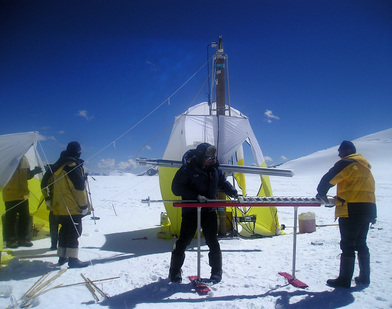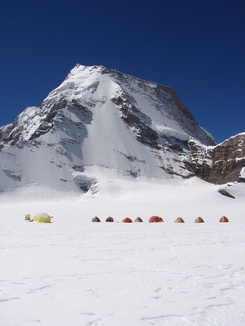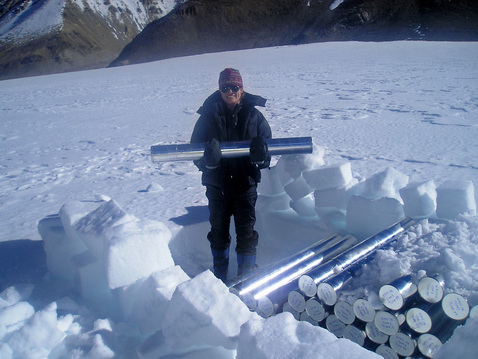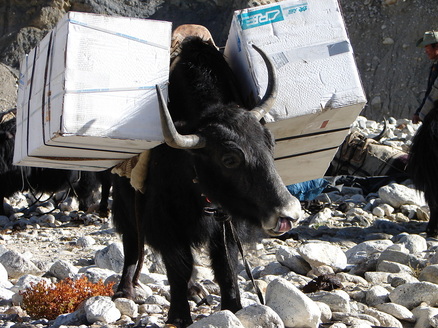 Drilling glacial core samples in Tibet. (Photos by Natalie Kehrwald)
Drilling glacial core samples in Tibet. (Photos by Natalie Kehrwald)
By Emily Wolfe
Natalie Kehrwald thought she was making a mistake. As a Ph.D. student at Ohio State University in 2008, she had just returned from a 2.5-month expedition collecting ice cores from a glacier at 20,000 feet in Tibet.
To date the ice, Kehrwald was looking for the layers of radioactive isotopes present in glaciers worldwide, deposited during Soviet nuclear testing in 1962-1963 and U.S. testing in 1952-1958.
“If you find those, you have an exact date and an idea of how much snow and ice has accumulated over top of that,” she says.
But Kehrwald couldn’t find the isotopes.
So she analyzed a parallel core, still not finding either radioactive peak. With a colleague, she performed additional tests with the same results. Finally they looked at the uppermost ice and found it dated from the 1940s, which means any accumulation from that time on had melted.
This was the first time anyone had proven that glaciers thin from the top down at such high elevations in the Himalaya, and it had massive implications.
Natalie Kehrwald: [In addition to glacial thinning,] I also study interactions between fires and climate. I’m looking for correlations between humans arriving in a place and increased fire activity, or if fire activity is more driven by changes in climate.
Specifically, I look at different traces of past biomass burning in ice cores. Fires can put up to half as much carbon dioxide into the atmosphere as fossil fuels… Even so, we don’t know how they affect atmospheric heating.
ASC: Wildfires or cooking fires?
N.K.: Historically, it was mostly wildfires, but in the present day, cooking fires are a bigger part of the total. Fires [create] a huge carbon dioxide influx into the atmosphere, where the net sum equals half as much as fossil fuels.
N.K.: The past 10,000 years. That period is exciting, because [the Earth had] just come out of the last ice age into a climate similar to what we have now. It’s also a time when humans have been really active – traveling around the world, starting agriculture, doing slash and burn techniques, and moving to locations like northern Scandinavia that were previously unoccupied.
ASC: Where have you collected samples?
N.K.: Most recently I’ve been to the Dolomites, where we did a deep drilling project in the Alps on a mountain called Ortles. I’ve also been to Central Greenland; the west Antarctic ice sheet; the central Himalayas in Tibet, and to the Cordillera Blanca in Peru.
ASC: How do you get equipment to a glacier at 20,000 feet, and then bring samples home?
N.K.: We drive until we can’t drive anymore, and then bring it up with animals – yaks in Himalayas and donkeys in South America. We build a base camp on the glacier, and do multiple hikes for tents and equipment and food, acclimatizing really, really slowly. Eventually you go up and live up there.
 Field camp at 20,000 feet in Tibet
Field camp at 20,000 feet in Tibet
We have a freezer truck, but the freezers don’t work at elevation, so we hook up oxygen tanks to the freezer component and drive as fast as we can for three days and two nights across places where there aren’t always roads to get to a commercial freezer. Then we ship it on a cold bed flight back to the U.S.
ASC: How have ASC athletes helped your work?
N.K.: That type of glacial thinning is really hard to see with satellites. You need to go by foot to get actual glacier samples, which is why I’m really excited about ASC. People are going to great locations and can get samples.
ASC: What is the protocol for our adventurers?
N.K.: They’re filling 8-15 Nalgene bottles, ideally going two meters below the surface by digging a pit or going down in a crevasse. The techniques are super easy. You end up adding volume to someone’s pack, which is why I ask people to do it at base camp.


